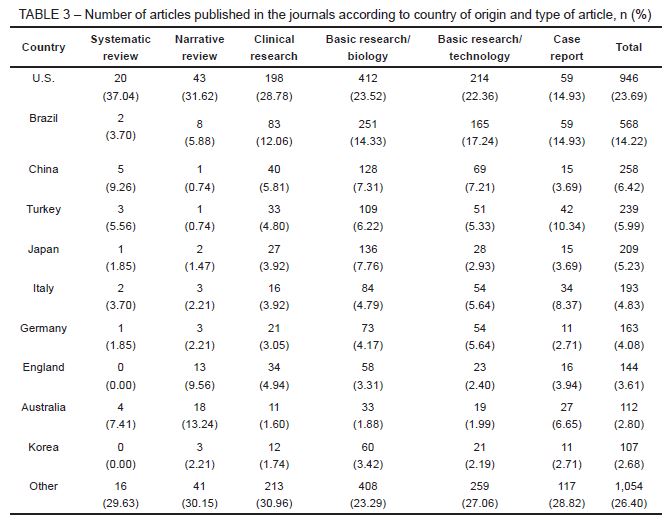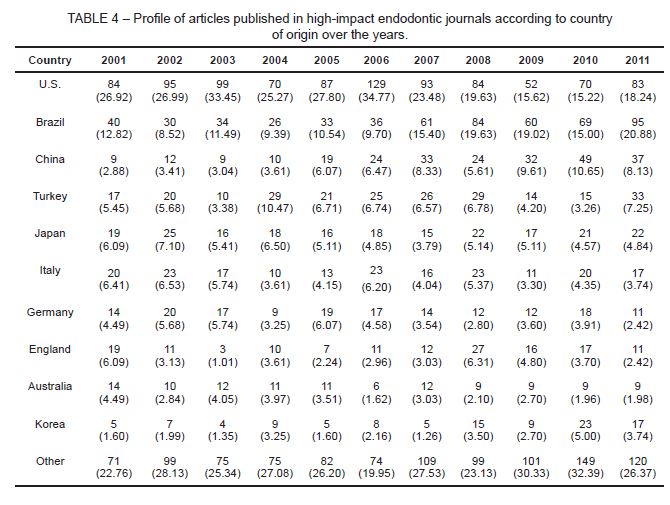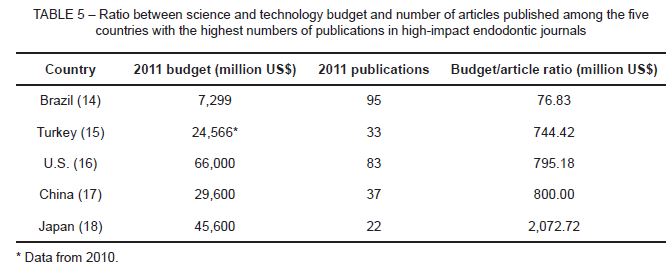Stomatos
ISSN 1519-4442
Stomatos vol.19 no.36 Canoas ene./jun. 2013
ORIGINAL ARTICLE / ARTIGO ORIGINAL
Profile of scientific production in endodontics in high-impact journals
Perfil da produção científica em endodontia em periódicos de alto impacto
Felipe Cavalcanti SampaioI; Ana Helena Gonçalves de AlencarII; Ranielle do Prado Ataídes CheinIII; Daniel de Almeida DecurcioII; Carlos EstrelaIV
I Graduate student (Master's degree) at the Department of Oral Sciences, Federal University of Goiás, Goiânia, GO, Brazil
II Professors of Endodontics at the Department of Oral Science, Federal University of Goiás, Goiânia, GO, Brazil
III Afiliated with the Department of Oral Sciences, Federal University of Goiás, Goiânia, GO, Brazil
IV Chairman and professor of Endodontics at the Department of Oral Science, Federal University of Goiás, Goiânia, GO, Brazil
ABSTRACT
Objective: To characterize the profile of scientific production in the field of endodontics in high-impact journals. Methods: Articles published from January 2001 to December 2011 in the Journal of Endodontics, International Endodontic Journal, and Australian Endodontic Journal were evaluated. Various aspects were assessed: type of article, authors' geographic origin, changes in the profile of papers over the studied period (in terms of country of origin and type of article), and ratio between budget for science/technology and number of publications. Results: A total of 3,993 articles were published in the 10-year period assessed. Basic research articles accounted for 67.85% of the production, compared to 1.35% of systematic reviews/meta-analyses. The U.S. ranked first in number of publications (23.69%), followed by Brazil (14.22%) and China (6.42%). Despite the low investments made in science, the emerging countries Brazil, China, and Turkey were able to figure among the top five countries in number of publications, especially as a result of increasing numbers of articles in the latest years. Conclusion: Emerging countries are investing increasing amounts in science and technology, which has allowed for a large number of publications in high-impact journals. Keywords: Endodontics, science, technology, impact factor, journal article.
Keywords: Endodontics, science, technology, impact factor, journal article.
RESUMO
Objetivo: Caracterizar o perfil da produção científica na área de endodontia em periódicos de alto impacto. Métodos: Foram avaliados os artigos publicados entre janeiro de 2001 e dezembro de 2011 nos periódicos Journal of Endodontics, International Endodontic Journal e Australian Endodontic Journal. Vários aspectos foram avaliados, a saber: tipo de artigo, origem geográfica dos autores, mudanças no perfil dos artigos ao longo do período estudado (em termos de país de origem e tipo de artigo) e relação entre o investimento em ciência/tecnologia e o número de publicações. Resultados: Um total de 3.993 artigos foram publicados no período de 10 anos estudado. Artigos de pesquisa básica representaram 67,85% da produção, comparados com 1,35% de revisões sistemáticas/metanálises. Os Estados Unidos ficaram em primeiro lugar em número de publicações (23,69%), seguidos pelo Brasil (14,22%) e pela China (6,42%). Apesar dos baixos investimentos feitos em ciência, os países emergentes Brasil, China e Turquia ficaram entre os cinco países com maiores números de publicações, especialmente como resultado do aumento nos números de artigos nos anos mais recentes. Conclusão: Países emergentes estão investindo cada vez mais em ciência e tecnologia, o que permitiu um grande número de publicações em periódicos de alto impacto nos últimos anos.
Palavras-chave: Endodontia, ciência, tecnologia, fator de impacto, artigo de revista.
INTRODUCTION
Scientific research has long been recognized as essential for economic growth in developed countries, and it is now also gaining recognition in emerging countries. One of the effects of this recognition is an increase in investments in science and technology 1. Moreover, the number of professionals dedicated to this activity has increased considerably. Finally, and as a result of those two phenomena, scientific journals and publications have also increased 2-4, a trend that is also observed in dentistry 2,5,6.
The quality of published research may and should be questioned by readers. In addition to the dental contents, the reader should also be able to understand and evaluate methodological and statistical aspects, beyond the study's proposition and conclusion 7. In this scenario, the journal impact factor emerged as a quality indicator of the papers published, as journals indexed in the database that calculates this measure have stricter criteria for the analysis of manuscripts submitted 8.
Journal impact factor is a quantitative tool for evaluating journals. Impact factors are published every year in the Journal Citation Report (JCR) and were created by Thomson Reuters (former Institute for Scientific Information, ISI). The impact factor is calculated based on a 3-year period, and can be considered to be the average number of times published papers are cited up to two years after publication 9.
Many journals are published specifically in the field of endodontics, but only a few of them have a high impact factor. The Journal of Endodontics (JOE) has the highest impact factor in the field (3,291), and the International Endodontic Journal (IEJ) is second (2,383). The Australian Endodontic Journal (AEJ) also has a high impact factor (1,239).
In addition to the journal impact factor, research design is a decisive factor when assessing the strength of the evidence produced. Basic science studies, such as cell studies and investigations of the properties of materials, are important to advance scientific knowledge, but they are not sufficient to promote an evidence-based endodontics. This practice requires clinical studies and systematic reviews, considered to be the top levels in the evidence pyramid, suitable to consolidate scientific knowledge and properly answer the professional's questions 10,11.
Despite the importance of knowing the profile of research produced in endodontics, no studies have so far been conducted with this purpose. Thus, this study aimed to characterize the profile of scientific production in the field of endodontics in high-impact journals.
METHODS
The sample included all volumes published from January 2001 to December 2011 by three high-impact endodontic journals: JOE, IEJ, and AEJ. These journals were selected based on the importance and impact of their publications in the field of endodontics, and for their recognition as state-of-the-art scientific journals from America, Europe, and Asia/Oceania, respectively.
A total of 3,993 articles were retrieved and analyzed, namely, 2,493 (62.43%) from JOE, 1,280 (32.06%) from IEJ, and 220 (5.51%) from AEJ.
The following data were evaluated for each article: type of article, authors' geographic origin, changes in the profile of papers over the studied period (in terms of country of origin and type of article), and ratio between budget allocated for science/ technology and number of endodontic publications.
Type of article was determined based on the JOE sessions, defined as follows:
1. Systematic review/meta-analysis: a review with a specific clinical question, congregating results from clinical studies with a well-defined, reproducible methodology 12;
2. Narrative literature review: a descriptive review that provides an overview about a particular topic 12;
3. Clinical research: experimental or observational studies involving humans/ patients 13;
4. Basic research/biology: includes animal experiments, cell studies, genetic and physiological investigations 13;
5. Basic research/technology: includes biomechanical investigations and studies of the properties of medications and materials 13;
6. Case report: descriptive study consisting of a detailed report of a patient's case or condition 10.
Geographic origin was defined as the country where the authors' institution belonged. Changes in the profile of papers published over the studied period focused on these two categories (type of article and country of origin). The science and technology budget of the five countries with the highest numbers of publications were described for year 2011 according to official sources 14-18 and related to the number of publications from each country. The ratio was calculated by dividing the total budget for science and technology by the total number of articles published in 2011.
Data were expressed as absolute and relative frequencies and analyzed using descriptive statistics.
RESULTS
The JOE is a monthly journal (12 issues per year) that has increased the number of articles published from 212 in 2001 to 292 in 2011 (226.63 articles per year; range: 164- 307). The IEJ is also published monthly and has increased the number of articles from 81 in 2001 to 133 in 2011 (116.36 articles per year; range: 81-139). Finally, the AEJ is published every 4 months (three issues per year), and has also increased the number of articles, from 19 in 2001 to 30 in 2011 (20.00 articles per year; range: 11-30).
Table 1 describes the types of article published by each of the journals analyzed: basic studies in the field of biology showed the highest number of articles (43.88%). Table 2 shows the country of origin of the authors' institution. American institutions accounted for the majority of published articles (23.69%). Table 3 shows the types of article published according to country of origin. Again, the U.S. ranked first in every category, but for case reports, in which the same result was observed for Brazil. Changes in the profile of articles published over the period assessed are described in Table 4. Developed countries, e.g., the U.S. and Japan, showed little changes, while emerging countries, e.g., Brazil, China, and Turkey, showed an important growth in their scientific production in the field of endodontics in the latest years assessed.




Table 5 shows the science and technology budget of the five countries with the highest numbers of articles published in high-impact endodontic journals and its relationship with the number of publications in 2011. The budget allocated for science and technology by the two developed countries was significantly higher than that allocated by the emerging countries.

DISCUSSION
Articles published in high-impact endodontic journals represent the state of the art of scientific knowledge produced in the field around the world. JOE, IEJ, and AEJ are three top quality endodontic journals, with high impact factors, coming from different continents. As a result, they disseminate knowledge produced at different regions and can help improve our understanding of the profile of scientific production worldwide.
As expected, the U.S. accounted for almost a quarter of all articles published. Brazil and China ranked second and third, respectively, in number of publications, corroborating the impression that emerging countries are increasing their share in producing scientific knowledge. A previous study designed to evaluate the contributions of different world regions in the top 50 biomedical journals from 1995 to 2002 found that developed regions were responsible for the majority of the scientific production contribution 4. This finding provides further evidence of the increment in scientific production coming from emerging countries in the last few years 1.
In 2004, Cury 19 described a significant increase in the number of Brazilian dental publications indexed in MEDLINE: the number of publications indexed in the first three years of this century (n=758) was almost double the number of journals indexed in the entire previous century (n=423). According to the author, this increase was motivated by the policies established at the Coordination for the Improvement of Higher Education Personnel (CAPES) and at the National Council for Scientific and Technological Development (CNPq), which encouraged researchers to publish their papers in high-impact journals 19,20.
This study observed a significant relationship between number of publications in high-impact endodontic journals and the budget allocated for science and technology in each country. Japan was the country with the highest ratio, as high as 2,072.72 million US$ per article. U.S. had the highest number of publications, which probably also refl ected the high budget allocated to science and technology 16. These data suggest that investment in science and technology ultimately leads to a high number of scientific publications.
Emerging countries showed great differences in their science and technology budgets in 2011. While China and Turkey had the third and fourth highest budgets 15,17, Brazil 14 had a budget almost four times lower than that of China. Conversely, the number of Brazilian articles in high-impact journals was greater than those of the other two countries and even than the number of Japanese articles. Moreover, the specific budget share allocated to the health sciences area, especially to dentistry and endodontics, may have influenced the results. Such difference could probably explain, for example, why Japan had the second highest budget but the lowest number of publications, and also why Brazil ranked second in number of publications but spent much less per article than the other four countries. Finally, the policies established by each country to evaluate their own scientific production may also infl uence the number of scientific publications in high- impact journals 19,20.
The types of studies conducted in a give field of science are decisive in producing and advancing knowledge. Particularly in dentistry, evidence-based articles have long been advocated as essential to transform clinical practice 12. In the scientific evidence pyramid, created to illustrate the quality of scientific evidence originating from different types of study, systematic reviews and meta-analyses come first, as they congregate findings produced by clinical trials and discuss their results 11,12. Despite the high value of such studies, these were the least frequent types of research published. This is in line with a recent study showing complete absence of systematic reviews among the 100 top cited articles in endodontic journals 21.
Basic studies were the ones showing the highest numbers. Biology and technology together were responsible for 67.78% of the scientific production in the field of endodontics from 2001 to 2011. Notwithstanding, these studies rank low in the evidence pyramid 11,12. Even though it is important to select the correct study type according to the design of each research project, scientific questions can only be properly answered if the study is performed at a qualitatively high level 13. Moreover, the power of research to answer a scientific question should be analyzed taking into consideration the level of evidence associated with each study design 12. As a result, for some questions, the scientific evidence available may not be strong enough to adequately help find an answer.
CONCLUSION
Emerging countries are investing increasing amounts in science and technology, which has allowed for a large number of publications in high-impact journals.
REFERENCES
1. Saravia NG, Miranda JF. Plumbing the brain drain. Bull World Health Organ. 2004;82(8):608-15. [ Links ]
2. Scariot R, Stadler AF, Assuncao CM, Pintarelli TP, Ferreira FM. A map of Brazilian dental research in the last decade. Braz Oral Res. 2011;25(3):197-204. [ Links ]
3. Figueredo E, Sanchez Perales G, Munoz Blanco F. International publishing in anaesthesia – how do different countries contribute? Acta Anaesthesiol Scand. 2003;47(4):378-82.
4. Soteriades ES, Rosmarakis ES, Paraschakis K, Falagas ME. Research contribution of different world regions in the top 50 biomedical journals (1995-2002). FASEB J. 2006;20(1):29-34. [ Links ]
5. Savage NW. Oral medicine in Australia 2000-2010. A publications overview. Aust Dent J. 2010;55 Suppl 1:3-8. [ Links ]
6. Ferraz VC, Amadei JR, Santos CF. The evolution of the Journal of Applied Oral Science: a bibliometric analysis. J Appl Oral Sci. 2008;16(6):420-7. [ Links ]
7. du Prel JB, Rohrig B, Blettner M. Critical appraisal of scientific articles: part 1 of a series on evaluation of scientific publications. Dtsch Arztebl Int. 2009;106(7):100-5. [ Links ]
8. Kumar V, Upadhyay S, Medhi B. Impact of the impact factor in biomedical research: its use and misuse. Singapore Med J. 2009;50(8):752-5. [ Links ]
9. Journal impact factors. Available from: http://www.sciencegateway.org/impact/ [ Links ]
10. Freire MC, Pattussi MP. Tipos de estudo. In: Estrela C, editor. Metodologia científica. 2ª ed. São Paulo: Artes Médicas; 2005. p. 185-210. [ Links ]
11. Jonas WB. The evidence house: how to build an inclusive base for complementary medicine. West J Med. 2001;175(2):79-80. [ Links ]
12. Leles CR, Freire MCM. Odontologia baseada em evidências. In: Estrela C, editor. Metodologia científica. 2ª ed. São Paulo: Artes Médicas; 2005. p.475-88. [ Links ]
13. Rohrig B, du Prel JB, Wachtlin D, Blettner M. Types of study in medical research: part 3 of a series on evaluation of scientific publications. Dtsch Arztebl Int. 2009;106(15):262-8. [ Links ]
14. Brasil, Ministério do Planejamento, Orçamento e Gestão. Orçamentos da União. Exercício financeiro 2011: projeto de lei orçamentária. Brasília, 2010. Available from: http://www.planejamento.gov.br/secretarias/upload/Arquivos/noticias/sof/PLOA2011-VolumeIV-TomoI.pdf [ Links ]
15. Metris, European Commission. Country report: social sciences and humanities. Turkey – 2011 Report. Available from: http://www.metrisnet.eu/metris//fileUpload/countryReports/Turkey_2011.pdf
16. U.S. Office of Science and Technology Policy. Investing in the building blocks of American innovation: Federal R&D, Technology, and STEM Education in the 2011 Budget. Available from: http://www.whitehouse.gov/sites/default/files/fy2011rd_final.pdf [ Links ]
17. Jia H. China hints at science-funding reform. Nature. doi:10.1038/news.2011.173. Available from: http://www.nature.com/news/2011/110321/full/news.2011.173.html [ Links ]
19. Cury J. The evolution of dental research in Brazil [editorial]. Braz Oral Res. 2004;18(2). Available from: http://www.scielo.br/pdf/pob/v18n2/a01v18n2.pdf
18. Japan National Science Foundation, Tokyo Regional Office. Japanese Government S&T Budget Proposal – JFY2011: An Increase of 2.1 percent from the previous year. Available from http://www.nsftokyo.org/rm11-02.pdf
20. Cury JA. The dilemma of researchers, the insensibility of policy-makers and the distress of Brazilian dentistry journals. Braz Oral Res. 2012;26(2):92. [ Links ]
21. Fardi A, Kodonas K, Gogos C, Economides N. Top-cited articles in endodontic journals. J Endod. 2011;37(9):1183-90. [ Links ]
 Corresponding Author:
Corresponding Author:
Carlos Estrela
Universidade Federal de Goiás – Departamento de Ciências Estomatológicas,
Praça Universitária s/nº, Setor Universitário, CEP 74605-220, Goiânia, GO, Brazil
E-mail:jorodrigues@ufrgs.br













